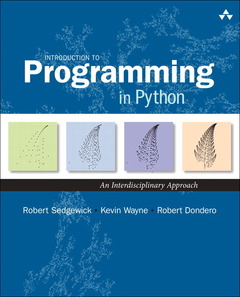Introduction to Programming in Python An Interdisciplinary Approach
Auteurs : Sedgewick Robert, Wayne Kevin, Dondero Robert

Today, anyone in a scientific or technical discipline needs programming skills. Python is an ideal first programming language, and Introduction to Programming in Python is the best guide to learning it.
Princeton University?s Robert Sedgewick, Kevin Wayne, and Robert Dondero have crafted an accessible, interdisciplinary introduction to programming in Python that emphasizes important and engaging applications, not toy problems. The authors supply the tools needed for students to learn that programming is a natural, satisfying, and creative experience.
This example-driven guide focuses on Python?s most useful features and brings programming to life for every student in the sciences, engineering, and computer science.
Coverage includes
- Basic elements of programming: variables, assignment statements, built-in data types, conditionals, loops, arrays, and I/O, including graphics and sound
- Functions, modules, and libraries: organizing programs into components that can be independently debugged, maintained, and reused
- Object-oriented programming and data abstraction: objects, modularity, encapsulation, and more
- Algorithms and data structures: sort/search algorithms, stacks, queues, and symbol tables
- Examples from applied math, physics, chemistry, biology, and computer science?all compatible with Python 2 and 3
Drawing on their extensive classroom experience, the authors provide Q&As, exercises, and opportunities for creative practice throughout. An extensive amount of supplementary information is available at introcs.cs.princeton.edu/python. With source code, I/O libraries, solutions to selected exercises, and much more, this companion website empowers people to use their own computers to teach and learn the material.
Preface xiii
Chapter 1: Elements of Programming 1
1.1 Your First Program 2
1.2 Built-in Types of Data 14
1.3 Conditionals and Loops 56
1.4 Arrays 100
1.5 Input and Output 140
1.6 Case Study: Random Web Surfer 188
Chapter 2: Functions and Modules 209
2.1 Defining Functions 210
2.2 Modules and Clients 248
2.3 Recursion 290
2.4 Case Study: Percolation 322
Chapter 3: Object-Oriented Programming 351
3.1 Using Data Types 352
3.2 Creating Data Types 402
3.3 Designing Data Types 450
3.4 Case Study: N-Body Simulation 496
Chapter 4: Algorithms and Data Structures 511
4.1 Performance 512
4.2 Sorting and Searching 556
4.3 Stacks and Queues 590
4.4 Symbol Tables 634
4.5 Case Study: Small-World Phenomenon 684
Context 729
Glossary 733
Index 739
Each section concludes with Q&A and Exercises.
Robert Sedgewick is the William O. Baker professor of computer science at Princeton University. He has held visiting research positions at several advanced research laboratories and serves on the Adobe Systems board. He is also the coauthor (with Kevin Wayne) of Introduction to Programming in Java and Algorithms, Fourth Edition (both from Addison-Wesley).
Kevin Wayne is the Phillip Y. Goldman senior lecturer in computer science at Princeton University, where he has taught since 1998. He is an ACM Distinguished Educator and holds a Ph.D. in operations research and industrial engineering
from Cornell University.
Robert Dondero is a lecturer in computer science at Princeton University. He has taught there since 2001, earning eight excellence in engineering education awards, and a lifetime achievement award for excellence in teaching. He holds
a Ph.D. in information science and technology from Drexel University.
- A broad-based, applications-based approach: teaches Python through examples from science, mathematics, engineering, and commercial computing
- Focuses on what matters most: the most useful and important Python language features
- Teaches through code tested for compatibility with Python 2.x and Python 3.x
- Includes question-and-answer sections, exercises, and creative exercises throughout
Date de parution : 06-2015
Ouvrage de 792 p.
18.9x24 cm



